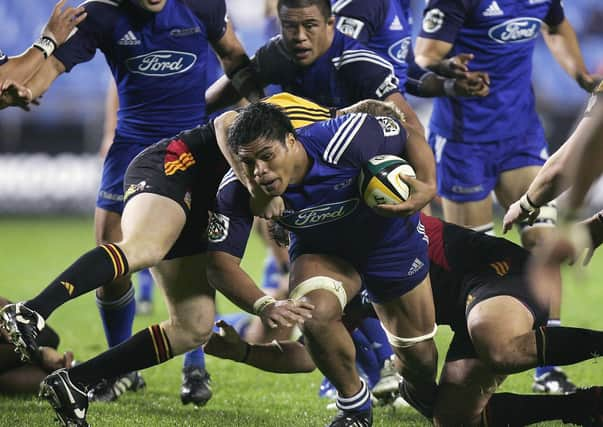Allan Massie: A wide berth is needed to ease excess of congestion that spoils modern rugby


I happened to come upon the highlights of the Chiefs v Blues match shown on the Welsh Language channel. Making allowances for the rustiness of the players and the fact that it was a wet night, I still found myself muttering “if these are the highlights, what can the rest of the game be like?” Certainly it was poor stuff: a lot of effort and much power, but precious little imagination or adventure and no flair at all.
This was partly because there was no space even when the ball was recycled quickly from the tackle-point; and there was no space because defences lay up flat and few players on either side were committed to the breakdown. This being so, the player taking a pass from the scrum-half or someone in the scrum-half position, almost invariably ran straight at a tackler to enable the same thing to happen all over again. The only variation came when the referee penalised someone at the breakdown, usually for coming in from the side; and this happened quite often.
Advertisement
Hide AdAdvertisement
Hide AdRugby is all about creating space: getting the ball or a player carrying the ball to a place where the opposition are either outnumbered or simply not there. One-pass rugby doesn’t even aim to create space; the tackle is taken in the hope that space will miraculously appear. It rarely does.
Laws may require amendment, but the sterility of so much rugby today isn’t all the fault of constricting laws. Japan showed what is possible within the present laws when they beat Ireland and Scotland in the World Cup, and we can all name exciting matches in recent years, not least the remarkable Calcutta Cup game at Twickenham in 2019. It’s also true that a lot of tries are scored now. It’s also, however, true that an awful lot of them are scored after repeated phases of biffing and barging within a few yards of the opposition try-line. Such tries, while of course satisfying when scored by your own team, aren’t very exciting. Too much rugby is played in congested areas, and this is partly because of a reluctance to risk moving the ball wide.
Talking of congestion, it’s hard to follow the programme for the return of rugby. Everyone is eager to see it happen, but we appear to be trying to put a quart in a pint pot. When what one would normally be thinking of as last season was unavoidably curtailed, the common sense response seemed to be simply to write it off, with the 2019-2020 leagues, cups and the Six Nations abandoned. This would have recognised that the normal season with leagues, European Cups, autumn internationals and the Six Nations is already very long and demanding. This approach has been rejected. Money talks. There are contracts, especially, but not only, with broadcasters , to be fulfilled. It is not known whether there have been negotiations concerning this. No matter, dates have been published for resumption of last season, even though we don’t yet know when rugby will be permitted – even behind closed doors.There are also, inevitably, tensions between clubs and the unions, especially in England where some Premiership clubs are in serious financial difficulties even though a lower salary cap has been agreed.
The national unions are in a similar position. It is not clear if any of the scheduled autumn internationals can be played. Southern hemisphere teams may be reluctant to risk coming to Britain, Ireland, France and Italy. There is talk, in France anyway, of an autumn international calendar. The last two rounds of the Six Nations interrupted in March would be played in October. Only Ireland and Italy still have two matches to play. They would meet on the 21st and onthe same day friendlies would be played between France and Scotland, Wales and England. The full last round which includes Scotland’s visit to Cardiff would follow on the 28th.
November would then include four weeks of international rugby in a Six Nations Cup, which, surprisingly, may include either Fiji or Japan, even conceivably both. This anyway is what the French press is reporting. Whether this is feasible may depend on the approval of World Rugby, supposedly due early this coming week.
The eagerness of the national unions is understandable. Covid-19 has upset all financial forecasts and television money for matches will do something to repair the damage even if there are no crowds or perhaps very limited socially distanced ones.
Yet at present it is all castles-in-the-air stuff. We are some way short of normal service being resumed, and this week provided us with an exemplary warning of the risks of going too soon. The fall-out from Novak Djokovic’s “Adria tour”dampens optimism more than somewhat.
A message from the Editor:
Thank you for reading this story on our website. While I have your attention, I also have an important request to make of you.
Advertisement
Hide AdAdvertisement
Hide AdThe dramatic events of 2020 are having a major impact on many of our advertisers - and consequently the revenue we receive. We are now more reliant than ever on you taking out a digital subscription to support our journalism.
Subscribe to scotsman.com and enjoy unlimited access to Scottish news and information online and on our app. Visit https://www.scotsman.com/subscriptions now to sign up.
By supporting us, we are able to support you in providing trusted, fact-checked content for this website.
Joy Yates
Editorial Director
Comments
Want to join the conversation? Please or to comment on this article.